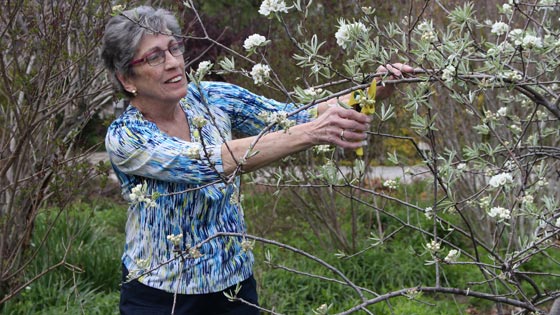
Trudy Stacey prunes a tree at the Toronto Botanical Garden where she has been volunteering since 1998. Last year, she participated in a trial to test a bronchodilator combination therapy that greatly improved her COPD symptoms. (Photo: UHN)
It's been a decade since Trudy Stacey was diagnosed with Chronic Obstructive Pulmonary Disease (COPD), but she hasn't let it slow her down.
Stacey, 73, shovels the snow on her walkway in the winter, takes trips to Europe and volunteers - most recently at the Toronto Botanical Garden Annual Spring Flower Show - which she has done since 1998 to kick off gardening season, a hobby she loves. However, as determined as she is to keep enjoying her favourite activities, COPD can sometimes get in the way.
COPD is a chronic lung disease that includes chronic bronchitis and emphysema. According to the Canadian Lung Association, COPD is mostly caused by smoking but can also result from second hand smoke, genetics, occupational dust and/or smoke, wood smoke or biomass fuels used for cooking, and childhood lung infections. In 2010, over 770,000 Canadians age 35 or older were living with COPD.
COPD develops gradually and causes permanent damage to the airways. When someone quits smoking, many illnesses related to tobacco smoke will improve, but the same can't be said for any lung damage already caused by COPD.
People living with COPD usually have a combination of symptoms that include persistent or recurring coughs often with mucus, feeling tired, constantly having difficulty breathing, and lung infections that last longer than usual.
In addition to these symptoms, COPD is also characterized by flare-ups which can lead to disability, hospitalization and, in some cases, death. Flare-ups occur when COPD symptoms suddenly worsen or new symptoms develop.
"Everything becomes difficult"
"The only thing I could do during a flare-up is sit still and watch television," recounts Stacey. "Everything becomes difficult: breathing, preparing food, even trying to get up to walk to the bathroom. It's actually a very scary experience and takes several days to get over."
Flare-ups can occur at any time. Stacey experienced one last year while on a trip to England, requiring her to take a day off sight-seeing and retreat to her hotel room.
"I always carry some prednisone with me and a prescription for antibiotics just in case I have to manage a flare-up," explains Stacey.
Although COPD is managed by daily doses of medication, symptoms are constant and it's difficult to prevent flare-ups. The medications also tend to include an inhaled steroid which, when used over a long period of time, can put some at increased risk of pneumonia and other side-effects associated with steroids.
For this reason, Stacey has regularly participated in clinical trials testing different treatments for COPD to help researchers find a drug that might work best.
That is how she came to be enrolled at the Canadian site of a trial led by Dr. Kenneth Chapman, a respirologist and Director of the Asthma and Airway Centre at Toronto Western Hospital. The trial was testing a combination of bronchodilators – inhaled medication to open the airways – for COPD patients with a history of flare-ups.
Encouraging results for COPD patients
In a study published on May 15 in the
New England Journal of Medicine, the trial results showed that patients using a once daily dose of dual bronchodilators – an inhaled long-acting β2-agonist with an inhaled long-acting muscarinic antagonist, or LABA/LAMA – was more effective at improving breathing function and preventing flare-ups than a commonly prescribed bronchodilator/inhaled corticosteroid combination. Furthermore, the LABA/LAMA combination was more effective and consistent in preventing COPD flare-ups whether they were mild, moderate or severe.
"These results are very encouraging for COPD patients," says Chapman who, in 1992, wrote the first Canadian guidelines for COPD management. "Patients who experience several flare-ups a year lose breathing capability more quickly and die sooner than those who don't. By 2020, COPD is expected to be the third most common disease on the planet, so we need to be able to offer the best treatment available to its sufferers."
The trial, called FLAME, was funded by pharmaceutical company Novartis.
The year-long trial was magical for Stacey who immediately saw a difference in her symptoms.
"It was the best thing I've ever had!" she says. "In general I just felt more comfortable and I also had fewer flare-ups."
Stacey credits her willingness to participate in research trials in helping her find the right treatment for her COPD.
"I tried a range of things over the years while participating in studies but had no idea I could feel this good," she says. "It's important for people to know what research is out there and take advantage of it – it's such a small thing to do for such a great benefit."
